Microsoft's Organization: Structure, Dynamics, and Growth Factors
VerifiedAdded on 2023/06/10
|9
|2625
|124
Case Study
AI Summary
This case study examines Microsoft's organizational structure, focusing on factors like market conditions, technology, strategy, and environment that influence it. It highlights characteristics such as product type divisions, global corporate groups, and geographical segments. The study also explores how Microsoft manages its dynamic processes through an accountable culture, innovation, R&D investment, rewards, diversity, and open communication. These strategies are crucial for shaping Microsoft's growth and success in the competitive IT industry. Desklib offers similar solved assignments and resources for students.
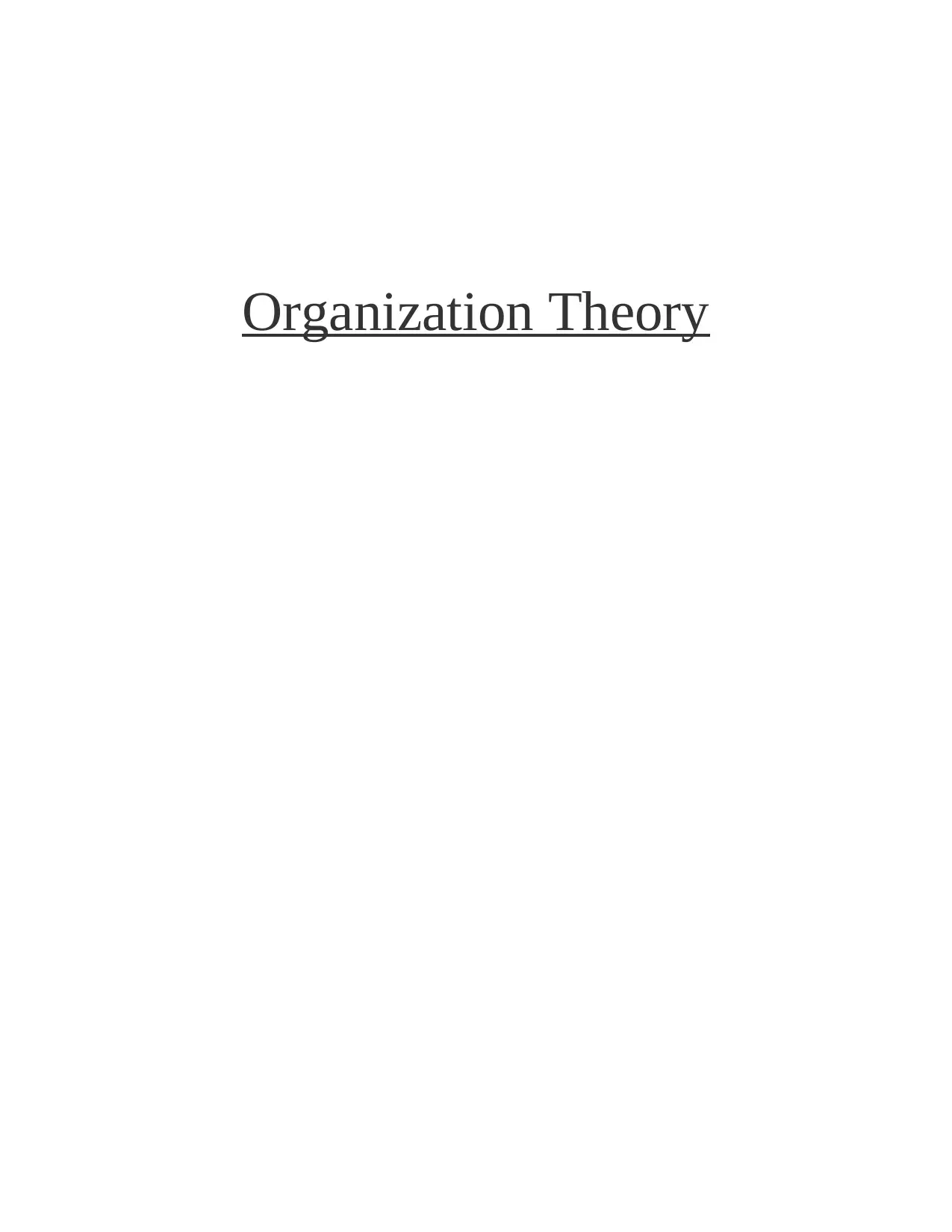
Organization Theory
Secure Best Marks with AI Grader
Need help grading? Try our AI Grader for instant feedback on your assignments.

Table of Contents
INTRODUCTION...........................................................................................................................3
MAIN BODY...................................................................................................................................3
Analysis of the factors that influence the organizational structure of Microsoft.........................3
Characteristics of the organisational structures of Microsoft .....................................................4
Ways through which Microsoft manages its dynamic processes in order to shape their growth
and success...................................................................................................................................6
CONCLUSION................................................................................................................................8
REFERENCES................................................................................................................................1
INTRODUCTION...........................................................................................................................3
MAIN BODY...................................................................................................................................3
Analysis of the factors that influence the organizational structure of Microsoft.........................3
Characteristics of the organisational structures of Microsoft .....................................................4
Ways through which Microsoft manages its dynamic processes in order to shape their growth
and success...................................................................................................................................6
CONCLUSION................................................................................................................................8
REFERENCES................................................................................................................................1

INTRODUCTION
Organisational structure is defined as a system that highlights various activities that are
directed towards achieving the goals and objectives of the company that includes the rules and
responsibilities of the employees and managers of the company. It also helps in determining the
flow and communication of the information at all the levels of the company. The organisational
structure of the company can be in the form of functional, divisional, flat and matrix. The present
case study is based on the Microsoft which is American multinational technology corporation
which deals in computer software, electronics, personal computers and related services.
MAIN BODY
Analysis of the factors that influence the organizational structure of Microsoft
The various factors that affect or influence the structure of Microsoft organization which
have to be understood by company are as follows:
Market conditions and Industry forces: This is one of the factor that affect the
organizational structure of company. It is because the company follow all the rules,
regulations in order to maintain the industry standards. Further, the market condition such
as demand of customer as well as their taste is also a factor that influence the
organizational structure of Microsoft. For example, Microsoft organization follow
product type divisional structure where the company uses product or output as one of the
main criteria to group their personnel related resources. However, Microsoft company do
not consider regional market difference for the formation of its organisational structure.
But the company should consider this as this factor highly influence the Microsoft
organizational structure (Tripathi and Jha, 2018).
Technology: This is another factor that influence the organisational structure of
Microsoft. It is because Microsoft is an informational technology company which is
highly get affected by the change in the technological innovation of business. Basically,
technology has vital role towards the success of Microsoft business so it is the prime duty
of company that they follow all the technological change and update their products based
on this change to achieve long-term success.
Strategy: It is important for the organization to understand that strategy is one of the
main factor that influence the structure of organization. It means a change in company
Organisational structure is defined as a system that highlights various activities that are
directed towards achieving the goals and objectives of the company that includes the rules and
responsibilities of the employees and managers of the company. It also helps in determining the
flow and communication of the information at all the levels of the company. The organisational
structure of the company can be in the form of functional, divisional, flat and matrix. The present
case study is based on the Microsoft which is American multinational technology corporation
which deals in computer software, electronics, personal computers and related services.
MAIN BODY
Analysis of the factors that influence the organizational structure of Microsoft
The various factors that affect or influence the structure of Microsoft organization which
have to be understood by company are as follows:
Market conditions and Industry forces: This is one of the factor that affect the
organizational structure of company. It is because the company follow all the rules,
regulations in order to maintain the industry standards. Further, the market condition such
as demand of customer as well as their taste is also a factor that influence the
organizational structure of Microsoft. For example, Microsoft organization follow
product type divisional structure where the company uses product or output as one of the
main criteria to group their personnel related resources. However, Microsoft company do
not consider regional market difference for the formation of its organisational structure.
But the company should consider this as this factor highly influence the Microsoft
organizational structure (Tripathi and Jha, 2018).
Technology: This is another factor that influence the organisational structure of
Microsoft. It is because Microsoft is an informational technology company which is
highly get affected by the change in the technological innovation of business. Basically,
technology has vital role towards the success of Microsoft business so it is the prime duty
of company that they follow all the technological change and update their products based
on this change to achieve long-term success.
Strategy: It is important for the organization to understand that strategy is one of the
main factor that influence the structure of organization. It means a change in company
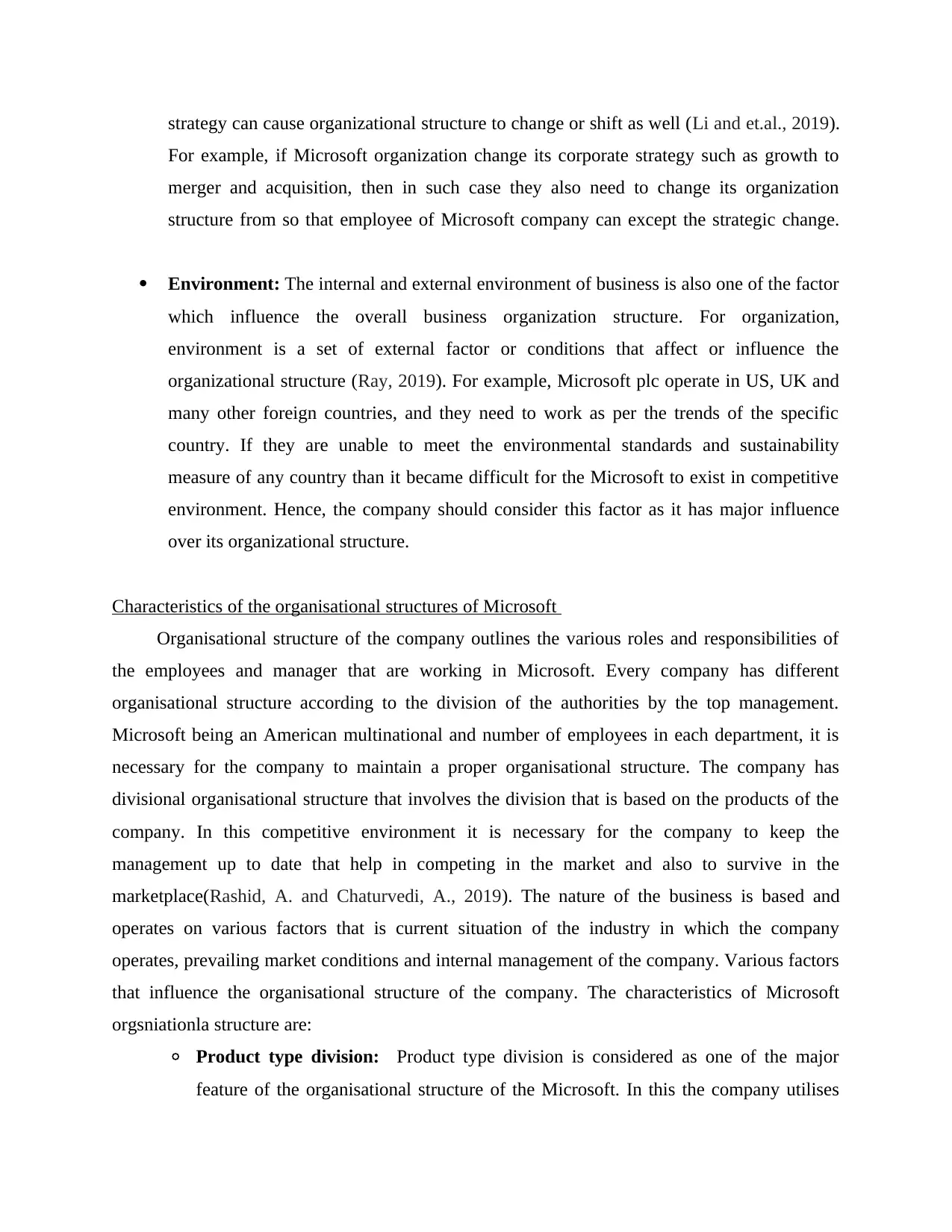
strategy can cause organizational structure to change or shift as well (Li and et.al., 2019).
For example, if Microsoft organization change its corporate strategy such as growth to
merger and acquisition, then in such case they also need to change its organization
structure from so that employee of Microsoft company can except the strategic change.
Environment: The internal and external environment of business is also one of the factor
which influence the overall business organization structure. For organization,
environment is a set of external factor or conditions that affect or influence the
organizational structure (Ray, 2019). For example, Microsoft plc operate in US, UK and
many other foreign countries, and they need to work as per the trends of the specific
country. If they are unable to meet the environmental standards and sustainability
measure of any country than it became difficult for the Microsoft to exist in competitive
environment. Hence, the company should consider this factor as it has major influence
over its organizational structure.
Characteristics of the organisational structures of Microsoft
Organisational structure of the company outlines the various roles and responsibilities of
the employees and manager that are working in Microsoft. Every company has different
organisational structure according to the division of the authorities by the top management.
Microsoft being an American multinational and number of employees in each department, it is
necessary for the company to maintain a proper organisational structure. The company has
divisional organisational structure that involves the division that is based on the products of the
company. In this competitive environment it is necessary for the company to keep the
management up to date that help in competing in the market and also to survive in the
marketplace(Rashid, A. and Chaturvedi, A., 2019). The nature of the business is based and
operates on various factors that is current situation of the industry in which the company
operates, prevailing market conditions and internal management of the company. Various factors
that influence the organisational structure of the company. The characteristics of Microsoft
orgsniationla structure are:
◦ Product type division: Product type division is considered as one of the major
feature of the organisational structure of the Microsoft. In this the company utilises
For example, if Microsoft organization change its corporate strategy such as growth to
merger and acquisition, then in such case they also need to change its organization
structure from so that employee of Microsoft company can except the strategic change.
Environment: The internal and external environment of business is also one of the factor
which influence the overall business organization structure. For organization,
environment is a set of external factor or conditions that affect or influence the
organizational structure (Ray, 2019). For example, Microsoft plc operate in US, UK and
many other foreign countries, and they need to work as per the trends of the specific
country. If they are unable to meet the environmental standards and sustainability
measure of any country than it became difficult for the Microsoft to exist in competitive
environment. Hence, the company should consider this factor as it has major influence
over its organizational structure.
Characteristics of the organisational structures of Microsoft
Organisational structure of the company outlines the various roles and responsibilities of
the employees and manager that are working in Microsoft. Every company has different
organisational structure according to the division of the authorities by the top management.
Microsoft being an American multinational and number of employees in each department, it is
necessary for the company to maintain a proper organisational structure. The company has
divisional organisational structure that involves the division that is based on the products of the
company. In this competitive environment it is necessary for the company to keep the
management up to date that help in competing in the market and also to survive in the
marketplace(Rashid, A. and Chaturvedi, A., 2019). The nature of the business is based and
operates on various factors that is current situation of the industry in which the company
operates, prevailing market conditions and internal management of the company. Various factors
that influence the organisational structure of the company. The characteristics of Microsoft
orgsniationla structure are:
◦ Product type division: Product type division is considered as one of the major
feature of the organisational structure of the Microsoft. In this the company utilises
Secure Best Marks with AI Grader
Need help grading? Try our AI Grader for instant feedback on your assignments.
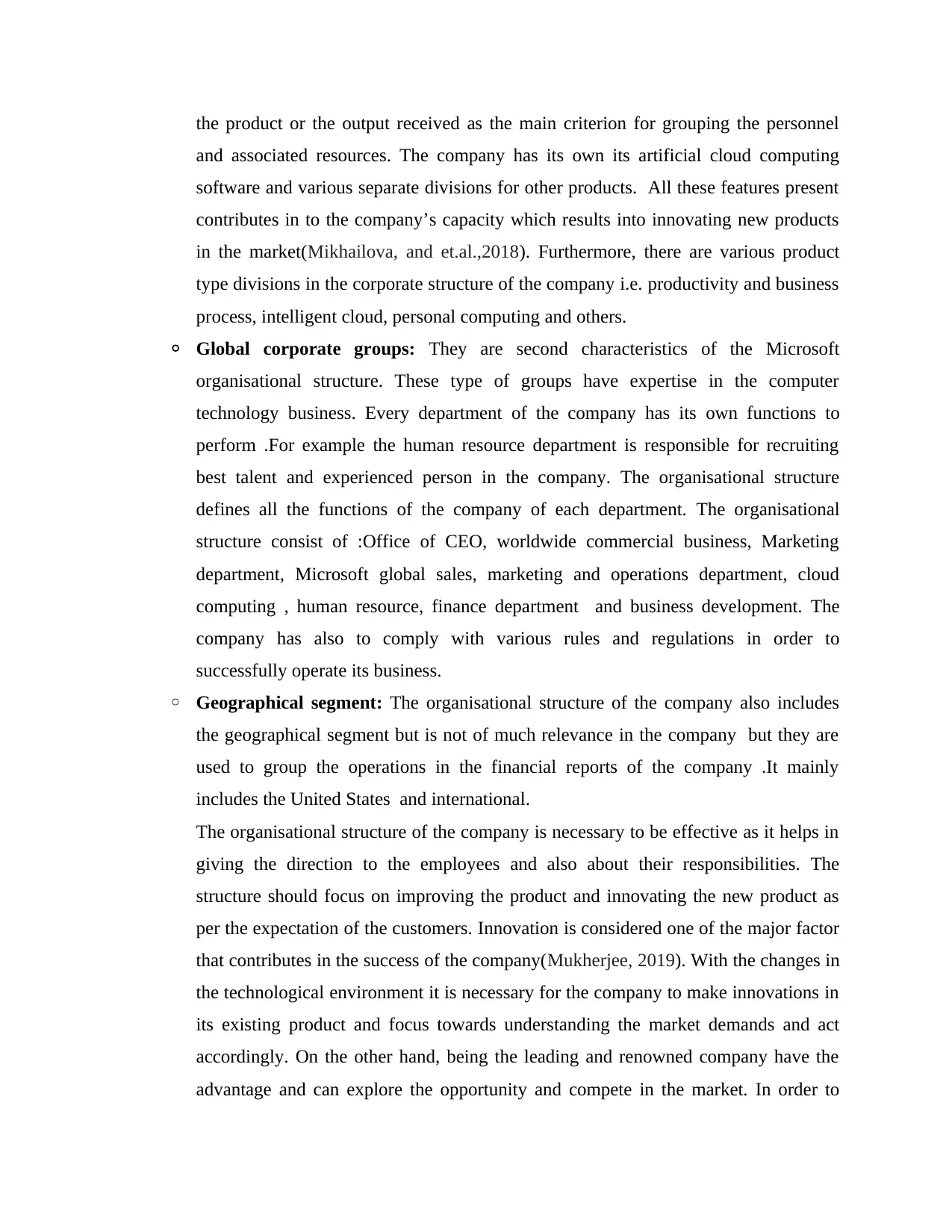
the product or the output received as the main criterion for grouping the personnel
and associated resources. The company has its own its artificial cloud computing
software and various separate divisions for other products. All these features present
contributes in to the company’s capacity which results into innovating new products
in the market(Mikhailova, and et.al.,2018). Furthermore, there are various product
type divisions in the corporate structure of the company i.e. productivity and business
process, intelligent cloud, personal computing and others.
◦ Global corporate groups: They are second characteristics of the Microsoft
organisational structure. These type of groups have expertise in the computer
technology business. Every department of the company has its own functions to
perform .For example the human resource department is responsible for recruiting
best talent and experienced person in the company. The organisational structure
defines all the functions of the company of each department. The organisational
structure consist of :Office of CEO, worldwide commercial business, Marketing
department, Microsoft global sales, marketing and operations department, cloud
computing , human resource, finance department and business development. The
company has also to comply with various rules and regulations in order to
successfully operate its business.
◦ Geographical segment: The organisational structure of the company also includes
the geographical segment but is not of much relevance in the company but they are
used to group the operations in the financial reports of the company .It mainly
includes the United States and international.
The organisational structure of the company is necessary to be effective as it helps in
giving the direction to the employees and also about their responsibilities. The
structure should focus on improving the product and innovating the new product as
per the expectation of the customers. Innovation is considered one of the major factor
that contributes in the success of the company(Mukherjee, 2019). With the changes in
the technological environment it is necessary for the company to make innovations in
its existing product and focus towards understanding the market demands and act
accordingly. On the other hand, being the leading and renowned company have the
advantage and can explore the opportunity and compete in the market. In order to
and associated resources. The company has its own its artificial cloud computing
software and various separate divisions for other products. All these features present
contributes in to the company’s capacity which results into innovating new products
in the market(Mikhailova, and et.al.,2018). Furthermore, there are various product
type divisions in the corporate structure of the company i.e. productivity and business
process, intelligent cloud, personal computing and others.
◦ Global corporate groups: They are second characteristics of the Microsoft
organisational structure. These type of groups have expertise in the computer
technology business. Every department of the company has its own functions to
perform .For example the human resource department is responsible for recruiting
best talent and experienced person in the company. The organisational structure
defines all the functions of the company of each department. The organisational
structure consist of :Office of CEO, worldwide commercial business, Marketing
department, Microsoft global sales, marketing and operations department, cloud
computing , human resource, finance department and business development. The
company has also to comply with various rules and regulations in order to
successfully operate its business.
◦ Geographical segment: The organisational structure of the company also includes
the geographical segment but is not of much relevance in the company but they are
used to group the operations in the financial reports of the company .It mainly
includes the United States and international.
The organisational structure of the company is necessary to be effective as it helps in
giving the direction to the employees and also about their responsibilities. The
structure should focus on improving the product and innovating the new product as
per the expectation of the customers. Innovation is considered one of the major factor
that contributes in the success of the company(Mukherjee, 2019). With the changes in
the technological environment it is necessary for the company to make innovations in
its existing product and focus towards understanding the market demands and act
accordingly. On the other hand, being the leading and renowned company have the
advantage and can explore the opportunity and compete in the market. In order to
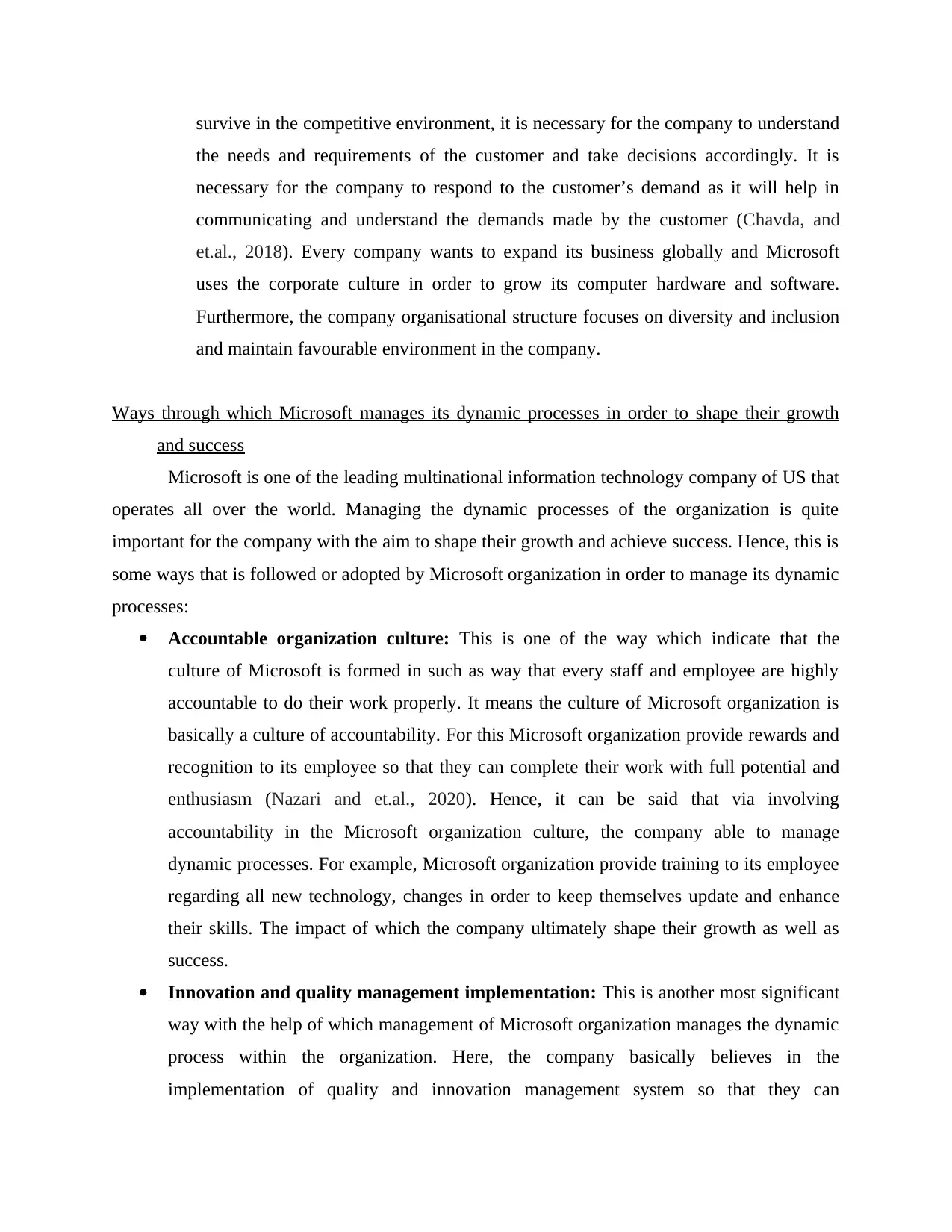
survive in the competitive environment, it is necessary for the company to understand
the needs and requirements of the customer and take decisions accordingly. It is
necessary for the company to respond to the customer’s demand as it will help in
communicating and understand the demands made by the customer (Chavda, and
et.al., 2018). Every company wants to expand its business globally and Microsoft
uses the corporate culture in order to grow its computer hardware and software.
Furthermore, the company organisational structure focuses on diversity and inclusion
and maintain favourable environment in the company.
Ways through which Microsoft manages its dynamic processes in order to shape their growth
and success
Microsoft is one of the leading multinational information technology company of US that
operates all over the world. Managing the dynamic processes of the organization is quite
important for the company with the aim to shape their growth and achieve success. Hence, this is
some ways that is followed or adopted by Microsoft organization in order to manage its dynamic
processes:
Accountable organization culture: This is one of the way which indicate that the
culture of Microsoft is formed in such as way that every staff and employee are highly
accountable to do their work properly. It means the culture of Microsoft organization is
basically a culture of accountability. For this Microsoft organization provide rewards and
recognition to its employee so that they can complete their work with full potential and
enthusiasm (Nazari and et.al., 2020). Hence, it can be said that via involving
accountability in the Microsoft organization culture, the company able to manage
dynamic processes. For example, Microsoft organization provide training to its employee
regarding all new technology, changes in order to keep themselves update and enhance
their skills. The impact of which the company ultimately shape their growth as well as
success.
Innovation and quality management implementation: This is another most significant
way with the help of which management of Microsoft organization manages the dynamic
process within the organization. Here, the company basically believes in the
implementation of quality and innovation management system so that they can
the needs and requirements of the customer and take decisions accordingly. It is
necessary for the company to respond to the customer’s demand as it will help in
communicating and understand the demands made by the customer (Chavda, and
et.al., 2018). Every company wants to expand its business globally and Microsoft
uses the corporate culture in order to grow its computer hardware and software.
Furthermore, the company organisational structure focuses on diversity and inclusion
and maintain favourable environment in the company.
Ways through which Microsoft manages its dynamic processes in order to shape their growth
and success
Microsoft is one of the leading multinational information technology company of US that
operates all over the world. Managing the dynamic processes of the organization is quite
important for the company with the aim to shape their growth and achieve success. Hence, this is
some ways that is followed or adopted by Microsoft organization in order to manage its dynamic
processes:
Accountable organization culture: This is one of the way which indicate that the
culture of Microsoft is formed in such as way that every staff and employee are highly
accountable to do their work properly. It means the culture of Microsoft organization is
basically a culture of accountability. For this Microsoft organization provide rewards and
recognition to its employee so that they can complete their work with full potential and
enthusiasm (Nazari and et.al., 2020). Hence, it can be said that via involving
accountability in the Microsoft organization culture, the company able to manage
dynamic processes. For example, Microsoft organization provide training to its employee
regarding all new technology, changes in order to keep themselves update and enhance
their skills. The impact of which the company ultimately shape their growth as well as
success.
Innovation and quality management implementation: This is another most significant
way with the help of which management of Microsoft organization manages the dynamic
process within the organization. Here, the company basically believes in the
implementation of quality and innovation management system so that they can

understand their competitors step and keep themselves competitive against other
hardware as well as software firms.
Investment in research and development: The heavy investment of research and
development is one of the way through which Microsoft organization manages dynamic
process within the organization and achieve the target on time. For example, the main
objective or strategic purpose of Microsoft organization includes product development. In
order to develop its product, the company usually do heavy investment in R&D with the
help of which company can understand the current and emerging trend in IT sector or
international market. On that basis, Microsoft manage its dynamic processes and closely
keep an eye towards all internal as well as external changes.
Rewards and 360 degree feedback: The employees are basically assets of organization
that play vital role in the success and growth of organization. Hence, Microsoft keep their
employee motivated and encouraged in order to manage all the dynamic or change
process. Under this step, Microsoft organization provide proper rewards and recognition
to its employee for their best performance as well as innovative ideas (Cole, Ramsook
and Ram, 2019). This help the company to keep their employee encourage and enhance
their morale the ultimate result of which the company such as Microsoft not only manage
changes but also achieve success or growth.
Diversity and Inclusion: Including diversity in the organization culture is also one of the
way to manage dynamic process. It is because when the people from different thoughts,
cultures and experience come along to work towards the success of organization, then the
chance of unique and innovative idea generation is increases. The result of which the
company able to achieve success and growth. For example, for Microsoft organization,
the inclusion and diversity is the most essential or significant factor that leads to company
development. Microsoft company always hire employee or talented staff from all over the
world with the aim to achieve success and provide individual success to them.
Effective open communication: Last but most important action or ways used by
Microsoft organization in order to manage dynamic or change process within the firm is
effective and open communication sessions with employees as well as customers. For
example, Microsoft organization conduct an open communication sessions with its
employees frequently with the aim that they can listen their issue and also provide
hardware as well as software firms.
Investment in research and development: The heavy investment of research and
development is one of the way through which Microsoft organization manages dynamic
process within the organization and achieve the target on time. For example, the main
objective or strategic purpose of Microsoft organization includes product development. In
order to develop its product, the company usually do heavy investment in R&D with the
help of which company can understand the current and emerging trend in IT sector or
international market. On that basis, Microsoft manage its dynamic processes and closely
keep an eye towards all internal as well as external changes.
Rewards and 360 degree feedback: The employees are basically assets of organization
that play vital role in the success and growth of organization. Hence, Microsoft keep their
employee motivated and encouraged in order to manage all the dynamic or change
process. Under this step, Microsoft organization provide proper rewards and recognition
to its employee for their best performance as well as innovative ideas (Cole, Ramsook
and Ram, 2019). This help the company to keep their employee encourage and enhance
their morale the ultimate result of which the company such as Microsoft not only manage
changes but also achieve success or growth.
Diversity and Inclusion: Including diversity in the organization culture is also one of the
way to manage dynamic process. It is because when the people from different thoughts,
cultures and experience come along to work towards the success of organization, then the
chance of unique and innovative idea generation is increases. The result of which the
company able to achieve success and growth. For example, for Microsoft organization,
the inclusion and diversity is the most essential or significant factor that leads to company
development. Microsoft company always hire employee or talented staff from all over the
world with the aim to achieve success and provide individual success to them.
Effective open communication: Last but most important action or ways used by
Microsoft organization in order to manage dynamic or change process within the firm is
effective and open communication sessions with employees as well as customers. For
example, Microsoft organization conduct an open communication sessions with its
employees frequently with the aim that they can listen their issue and also provide
Paraphrase This Document
Need a fresh take? Get an instant paraphrase of this document with our AI Paraphraser

solutions to them (Bundy, Vogel and Zachary, 2018). This is one of the best and most
significant strategy or ways used by Microsoft to manage dynamic process because with
the change of time the employees get demotivated. There are many issues that affect the
mindset of employee which ultimately leads to demotivation and in case when any
change occurs that they became violent and rude towards their work. In the same way, in
order to keep their customer engaged and solve their issues, Microsoft conduct live
seminars as well as get-together with the customer on both online and offline mode.
CONCLUSION
After summing up the above information, it has been analysed that Microsoft
organization is one of the leading and successful organization because of its organization
structure and culture. The report has concluded that market condition and industry forces,
technology, strategy and environment are some factors that influence the organization structure
of Microsoft. Further, the report has concluded the different characteristics of organizational
structure of Microsoft. Lastly, the report has concluded the factor ways which is used by
Microsoft to manage dynamic processes such as accountability, reward, training and
development, diversity inclusion etc. in order to shape organizational growth and success.
significant strategy or ways used by Microsoft to manage dynamic process because with
the change of time the employees get demotivated. There are many issues that affect the
mindset of employee which ultimately leads to demotivation and in case when any
change occurs that they became violent and rude towards their work. In the same way, in
order to keep their customer engaged and solve their issues, Microsoft conduct live
seminars as well as get-together with the customer on both online and offline mode.
CONCLUSION
After summing up the above information, it has been analysed that Microsoft
organization is one of the leading and successful organization because of its organization
structure and culture. The report has concluded that market condition and industry forces,
technology, strategy and environment are some factors that influence the organization structure
of Microsoft. Further, the report has concluded the different characteristics of organizational
structure of Microsoft. Lastly, the report has concluded the factor ways which is used by
Microsoft to manage dynamic processes such as accountability, reward, training and
development, diversity inclusion etc. in order to shape organizational growth and success.
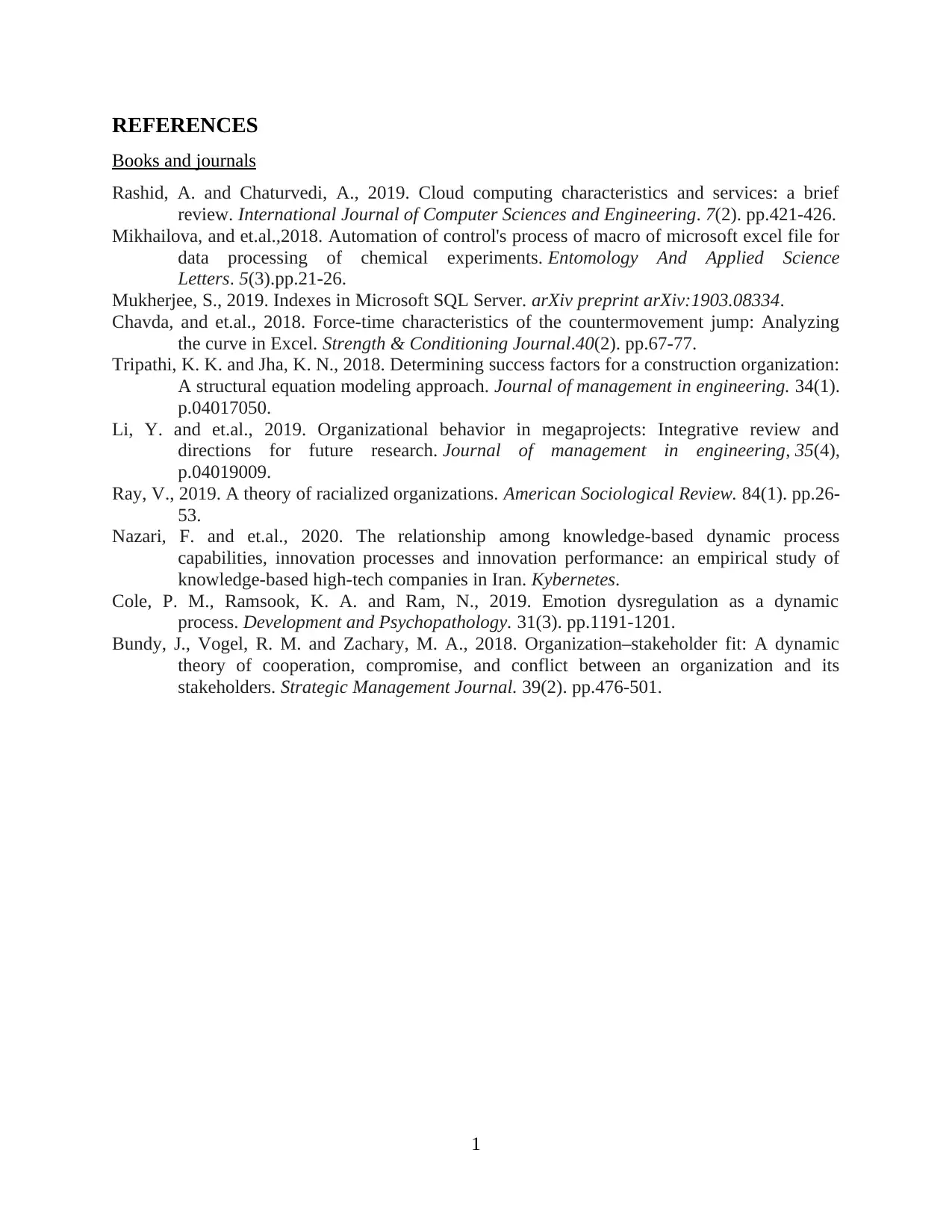
REFERENCES
Books and journals
Rashid, A. and Chaturvedi, A., 2019. Cloud computing characteristics and services: a brief
review. International Journal of Computer Sciences and Engineering. 7(2). pp.421-426.
Mikhailova, and et.al.,2018. Automation of control's process of macro of microsoft excel file for
data processing of chemical experiments. Entomology And Applied Science
Letters. 5(3).pp.21-26.
Mukherjee, S., 2019. Indexes in Microsoft SQL Server. arXiv preprint arXiv:1903.08334.
Chavda, and et.al., 2018. Force-time characteristics of the countermovement jump: Analyzing
the curve in Excel. Strength & Conditioning Journal.40(2). pp.67-77.
Tripathi, K. K. and Jha, K. N., 2018. Determining success factors for a construction organization:
A structural equation modeling approach. Journal of management in engineering. 34(1).
p.04017050.
Li, Y. and et.al., 2019. Organizational behavior in megaprojects: Integrative review and
directions for future research. Journal of management in engineering, 35(4),
p.04019009.
Ray, V., 2019. A theory of racialized organizations. American Sociological Review. 84(1). pp.26-
53.
Nazari, F. and et.al., 2020. The relationship among knowledge-based dynamic process
capabilities, innovation processes and innovation performance: an empirical study of
knowledge-based high-tech companies in Iran. Kybernetes.
Cole, P. M., Ramsook, K. A. and Ram, N., 2019. Emotion dysregulation as a dynamic
process. Development and Psychopathology. 31(3). pp.1191-1201.
Bundy, J., Vogel, R. M. and Zachary, M. A., 2018. Organization–stakeholder fit: A dynamic
theory of cooperation, compromise, and conflict between an organization and its
stakeholders. Strategic Management Journal. 39(2). pp.476-501.
1
Books and journals
Rashid, A. and Chaturvedi, A., 2019. Cloud computing characteristics and services: a brief
review. International Journal of Computer Sciences and Engineering. 7(2). pp.421-426.
Mikhailova, and et.al.,2018. Automation of control's process of macro of microsoft excel file for
data processing of chemical experiments. Entomology And Applied Science
Letters. 5(3).pp.21-26.
Mukherjee, S., 2019. Indexes in Microsoft SQL Server. arXiv preprint arXiv:1903.08334.
Chavda, and et.al., 2018. Force-time characteristics of the countermovement jump: Analyzing
the curve in Excel. Strength & Conditioning Journal.40(2). pp.67-77.
Tripathi, K. K. and Jha, K. N., 2018. Determining success factors for a construction organization:
A structural equation modeling approach. Journal of management in engineering. 34(1).
p.04017050.
Li, Y. and et.al., 2019. Organizational behavior in megaprojects: Integrative review and
directions for future research. Journal of management in engineering, 35(4),
p.04019009.
Ray, V., 2019. A theory of racialized organizations. American Sociological Review. 84(1). pp.26-
53.
Nazari, F. and et.al., 2020. The relationship among knowledge-based dynamic process
capabilities, innovation processes and innovation performance: an empirical study of
knowledge-based high-tech companies in Iran. Kybernetes.
Cole, P. M., Ramsook, K. A. and Ram, N., 2019. Emotion dysregulation as a dynamic
process. Development and Psychopathology. 31(3). pp.1191-1201.
Bundy, J., Vogel, R. M. and Zachary, M. A., 2018. Organization–stakeholder fit: A dynamic
theory of cooperation, compromise, and conflict between an organization and its
stakeholders. Strategic Management Journal. 39(2). pp.476-501.
1
1 out of 9
Related Documents
Your All-in-One AI-Powered Toolkit for Academic Success.
+13062052269
info@desklib.com
Available 24*7 on WhatsApp / Email
![[object Object]](/_next/static/media/star-bottom.7253800d.svg)
Unlock your academic potential
© 2024 | Zucol Services PVT LTD | All rights reserved.


